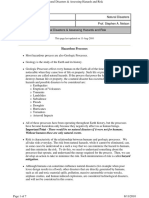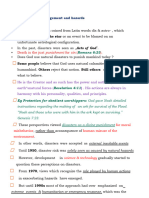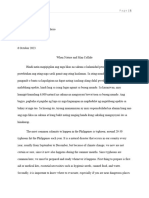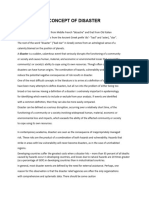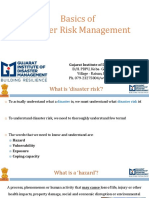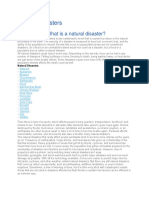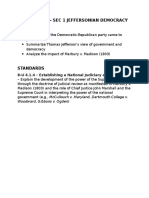U2 l7 2 What Are Natural Hazards
U2 l7 2 What Are Natural Hazards
Uploaded by
api-134134588Copyright:
Available Formats
U2 l7 2 What Are Natural Hazards
U2 l7 2 What Are Natural Hazards
Uploaded by
api-134134588Original Title
Copyright
Available Formats
Share this document
Did you find this document useful?
Is this content inappropriate?
Copyright:
Available Formats
U2 l7 2 What Are Natural Hazards
U2 l7 2 What Are Natural Hazards
Uploaded by
api-134134588Copyright:
Available Formats
Unit 2 Lesson 7: What are Natural Hazards?
The Earth is a dynamic place. Within nature nothing is constant. Indeed, nature is typified by
continual changes, in some cases by predictable change or the normal sequence of cyclical events
as in seasonal weather. Much of nature, though, is unpredictable. When unpredictable natural
events become extreme in their occurrence, they may constitute a danger to humans and to the
other members of an environment. Such an event, then, defines a natural hazard.
Another way of conceptualizing natural hazard is as the coexistence of people in a natural
environment that may disrupt or threaten their safety, property, or livelihood at an unpredictable
time. There are many such natural events that, when experienced in an extreme degree, may
become a risk to the inhabitants of an environment. These include avalanche, coastal erosion,
drought, earthquake, flood, fog, frost, hail, landslide, lightning, snow, tornado, tropical cyclone,
volcano, and wind.
It is important to understand that there is a relationship between natural hazards and
disasters. In fact, the hazard may be viewed as the triggering device for the disaster to occur.
Often times the disaster is brought on by the mere presence of human settlement in an area
that perhaps should not be occupied, as in flood plains. Or the impact of human intervention in
natural processes may trigger a disaster, as in a flash flood in a deforested area.
Why are natural hazards such a universal concern? The disasters they cause kill and injure
people worldwide. They cause emotional stress and trauma. They destroy homes and
businesses, damage agriculture, and disrupt both local and national economies. Disasters
are increasing, both in number and in people affected.
Adapted from: Natural Hazards: Causes and Effects. 20 September 2012
<http://epdfiles.engr.wisc.edu/dmcweb/BB02NaturalHazardsCausesandEffects.pdf>.
You might also like
- Unit 1 (A)Document17 pagesUnit 1 (A)Vidushi YadavNo ratings yet
- Assignment #1 Zarak Khan Mahsud CU-255-2016 Civil-B 20/03/2020 "Hazard & Disaster"Document4 pagesAssignment #1 Zarak Khan Mahsud CU-255-2016 Civil-B 20/03/2020 "Hazard & Disaster"Afrasayab KhanNo ratings yet
- Sean Lejee O. Bajan October 22, 2018 Grade 12 - Integrity Reflection PaperDocument2 pagesSean Lejee O. Bajan October 22, 2018 Grade 12 - Integrity Reflection PaperSeanLejeeBajanNo ratings yet
- Disaster Notes ImpDocument30 pagesDisaster Notes Imppuneet017No ratings yet
- Foundation Course - Disaster Management NOTESDocument54 pagesFoundation Course - Disaster Management NOTESnandhu ragavanNo ratings yet
- Introduction To DisasterDocument9 pagesIntroduction To DisasterNehal akhtarNo ratings yet
- Natural Disasters & Assessing Hazards and RiskDocument7 pagesNatural Disasters & Assessing Hazards and RiskAhmed AliNo ratings yet
- Environmental Science & Disaster ManagementDocument104 pagesEnvironmental Science & Disaster ManagementJyothis T SNo ratings yet
- Disaster Man ADocument81 pagesDisaster Man Ajhaprince1029No ratings yet
- Unit 1Document16 pagesUnit 1Harshit YadavNo ratings yet
- Concept PaperDocument4 pagesConcept Paperjulianne tanNo ratings yet
- Natural Disaster Management FDocument134 pagesNatural Disaster Management FLords Porseena100% (1)
- DRRRDocument26 pagesDRRRJemimah FV100% (1)
- Basic Concept of Disaster and RiskDocument41 pagesBasic Concept of Disaster and RiskTaylor SwiftieNo ratings yet
- Bahan 4Document9 pagesBahan 4EVINSYAH PUTRANo ratings yet
- Unit IDocument20 pagesUnit INikitha Shinde100% (1)
- Disaster Risk Management and HazardsDocument20 pagesDisaster Risk Management and HazardsAbez ZeledetaNo ratings yet
- DRRR POWERPOINT Types of HazardsDocument19 pagesDRRR POWERPOINT Types of HazardsKelsey Gaile MaghanoyNo ratings yet
- Naturals Hazards and Disasters 1Document18 pagesNaturals Hazards and Disasters 1Karyl Hann SarenNo ratings yet
- Unit 8Document22 pagesUnit 8dhanukrishnagNo ratings yet
- Disastermanagement 1Document60 pagesDisastermanagement 1vccgyugu jbuuNo ratings yet
- Ecowarriors DraftDocument3 pagesEcowarriors DraftChrista MonacoNo ratings yet
- Week 1 Disaster and Disaster RiskDocument4 pagesWeek 1 Disaster and Disaster RiskAilyn Uy Laparan DiolataNo ratings yet
- Concept of DisasterDocument4 pagesConcept of Disasterlyane.tipsay16No ratings yet
- DRRR-Notes1 1Document6 pagesDRRR-Notes1 1Claire TipayNo ratings yet
- Module 1 Concept of Disaster and Disaster RIsk (For Upload)Document11 pagesModule 1 Concept of Disaster and Disaster RIsk (For Upload)lagari leeNo ratings yet
- Basics of Disaster Risk ManagementDocument71 pagesBasics of Disaster Risk ManagementBhonuMainaNo ratings yet
- Ege 421-Lecture NotesDocument84 pagesEge 421-Lecture Noteshenry_koechNo ratings yet
- Est Microproject Vijaya FinalDocument13 pagesEst Microproject Vijaya Finalprernathange25No ratings yet
- Disaster Mitigation and Management ReserchDocument16 pagesDisaster Mitigation and Management ReserchRelaine MontierroNo ratings yet
- Basic Concept of HazardDocument53 pagesBasic Concept of HazardBETHUEL P. ALQUIROZNo ratings yet
- Disaster ManagementDocument3 pagesDisaster ManagementManpreet KaurNo ratings yet
- Unit 7Document19 pagesUnit 7yoda ssNo ratings yet
- NSTP 2 DisasterDocument1 pageNSTP 2 DisasterMae MendozaNo ratings yet
- Disaster Management Cycle6Document8 pagesDisaster Management Cycle6Lucia CamargoNo ratings yet
- Course Code Course Title: Semester School Year PeriodDocument6 pagesCourse Code Course Title: Semester School Year PeriodMori OugaiNo ratings yet
- Module 4 - Disaster Risk Reduction, Prevention and ControlDocument19 pagesModule 4 - Disaster Risk Reduction, Prevention and ControlMaurene MendozaNo ratings yet
- Natural DisastersDocument2 pagesNatural DisastersAgusNo ratings yet
- Cor010 DRR NotesDocument9 pagesCor010 DRR NotesgebsepteraNo ratings yet
- What Is Disaster ManagementDocument5 pagesWhat Is Disaster Management9536909268No ratings yet
- Natural Disasters Term PaperDocument4 pagesNatural Disasters Term Paperbctfnerif100% (1)
- Disaster Readiness and Risk ReductionDocument24 pagesDisaster Readiness and Risk ReductionEdgar Empeño Jr.No ratings yet
- 2) CSPDocument66 pages2) CSPArem Satish Kumar reddyNo ratings yet
- Basic Concept of Disaster and Disaster RDocument18 pagesBasic Concept of Disaster and Disaster RStephen Theodore T. DimalibotNo ratings yet
- Hazard & DisasterDocument2 pagesHazard & Disasteryuthgeorge99No ratings yet
- Disaster 1Document28 pagesDisaster 1AneeqaMieNo ratings yet
- Concept of DisasterDocument23 pagesConcept of Disastermixcky lopezNo ratings yet
- Handouts in DRRRDocument17 pagesHandouts in DRRRGiea Gay SeverinoNo ratings yet
- Multi Hazard Risk Assessment (Summary)Document30 pagesMulti Hazard Risk Assessment (Summary)masabatasneem29No ratings yet
- 1.what Is A Disaster ?Document2 pages1.what Is A Disaster ?smanikandanNo ratings yet
- Module-2-DISASTER-AND-DISASTER-RISK 2Document16 pagesModule-2-DISASTER-AND-DISASTER-RISK 2Thom Spencer Rosello CabilesNo ratings yet
- Final Exam (DRRR)Document1 pageFinal Exam (DRRR)Angelica RivamonteNo ratings yet
- DRRR Lesson 1.editedDocument6 pagesDRRR Lesson 1.editedLuvie Jhun GahiNo ratings yet
- Unit 1 Basic Concept of Disaster and Disaster Risk 2Document22 pagesUnit 1 Basic Concept of Disaster and Disaster Risk 2Miguel RavinaNo ratings yet
- Lecture 33-40 Disaster ManagementDocument35 pagesLecture 33-40 Disaster Managementdave pitumenNo ratings yet
- Topic 1 DRRR (Disaster Risk)Document32 pagesTopic 1 DRRR (Disaster Risk)Manilyn IbarraNo ratings yet
- Natural HazardDocument51 pagesNatural HazardLyra Virgilia AbellanaNo ratings yet
- M 3 Disaster Risk Reduction and ManagementDocument22 pagesM 3 Disaster Risk Reduction and ManagementRalph Andrei CastilloNo ratings yet
- Report On Disasters in Pakistan - Dr. Khan ShahzadaDocument14 pagesReport On Disasters in Pakistan - Dr. Khan ShahzadaHazrat Amin Lecturer Civil Jalozai CampusNo ratings yet
- Earth and Atmospheric Disaster Management Natural and Man-madeFrom EverandEarth and Atmospheric Disaster Management Natural and Man-madeNo ratings yet
- Lesson 4 AbstractDocument1 pageLesson 4 Abstractapi-134134588No ratings yet
- CH 6 Sec 1 Tighter British ControlDocument9 pagesCH 6 Sec 1 Tighter British Controlapi-1341345880% (1)
- Chapter-1-The World of GeographyDocument16 pagesChapter-1-The World of Geographyapi-134134588100% (1)
- Unit 2: Challenges To An Emerging Nation: Eighth Grade Social Studies: Integrated United States HistoryDocument4 pagesUnit 2: Challenges To An Emerging Nation: Eighth Grade Social Studies: Integrated United States Historyapi-134134588No ratings yet
- Lesson 7 AbstractDocument1 pageLesson 7 Abstractapi-134134588No ratings yet
- Lesson 1 AbstractDocument1 pageLesson 1 Abstractapi-134134588No ratings yet
- Lesson 2 AbstractDocument1 pageLesson 2 Abstractapi-134134588No ratings yet
- Intro Unit AbstractDocument1 pageIntro Unit Abstractapi-134134588No ratings yet
- CH 10 Sec 3 Problems With Foreign PowersDocument10 pagesCH 10 Sec 3 Problems With Foreign Powersapi-134134588No ratings yet
- Unit 1: Foundations of A New Nation: Eighth Grade Social Studies: Integrated United States HistoryDocument5 pagesUnit 1: Foundations of A New Nation: Eighth Grade Social Studies: Integrated United States Historyapi-134134588No ratings yet
- CH 10 Sec 2 The Louisiana Purchase and Exploration 1Document12 pagesCH 10 Sec 2 The Louisiana Purchase and Exploration 1api-134134588No ratings yet
- CH 9 Sec 3 The Federalists in ChargeDocument13 pagesCH 9 Sec 3 The Federalists in Chargeapi-134134588No ratings yet
- Activity 1 T or F QuizDocument1 pageActivity 1 T or F Quizapi-134134588No ratings yet
- The Bill of Rights Mini Poster ProjectDocument2 pagesThe Bill of Rights Mini Poster Projectapi-134134588No ratings yet
- Word Cards 1 - 13Document3 pagesWord Cards 1 - 13api-134134588No ratings yet
- CH 10 Sec 1 Jefferson Takes OfficeDocument8 pagesCH 10 Sec 1 Jefferson Takes Officeapi-134134588No ratings yet
- Chapter 10 Sec 1 AbstractDocument1 pageChapter 10 Sec 1 Abstractapi-134134588No ratings yet
- 7 Principles of The ConstitutionDocument1 page7 Principles of The Constitutionapi-134134588No ratings yet
- Chapter 10 - The Jefferson Era 1800-1816 Key IdeasDocument1 pageChapter 10 - The Jefferson Era 1800-1816 Key Ideasapi-134134588No ratings yet
- CH 9 Sec 2 Challenges To The New GovernmentDocument9 pagesCH 9 Sec 2 Challenges To The New Governmentapi-1341345880% (1)
- The Three Branches of Government 2Document15 pagesThe Three Branches of Government 2api-134134588No ratings yet
- What Is The Virginia Plan?: SupportersDocument7 pagesWhat Is The Virginia Plan?: Supportersapi-134134588No ratings yet
- Class Notes: Legacy of The War: American VictoryDocument36 pagesClass Notes: Legacy of The War: American Victoryapi-134134588No ratings yet






